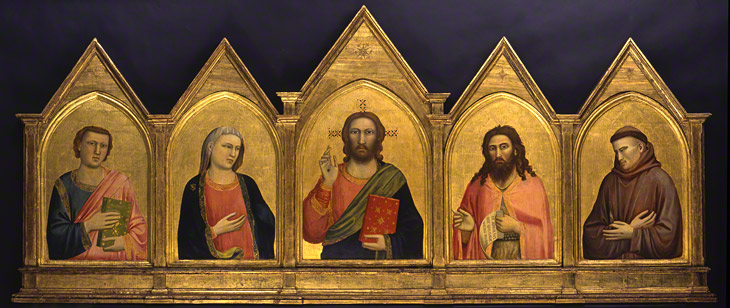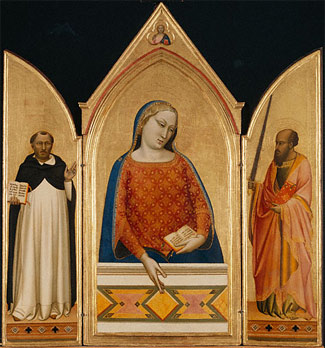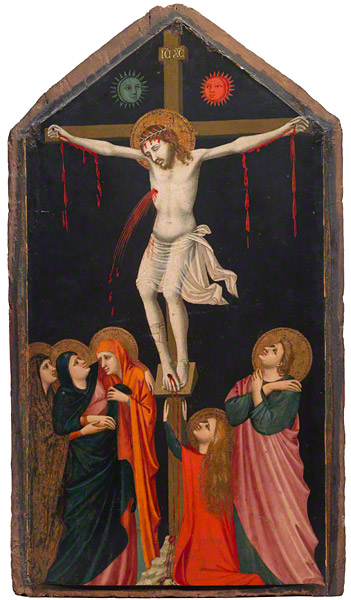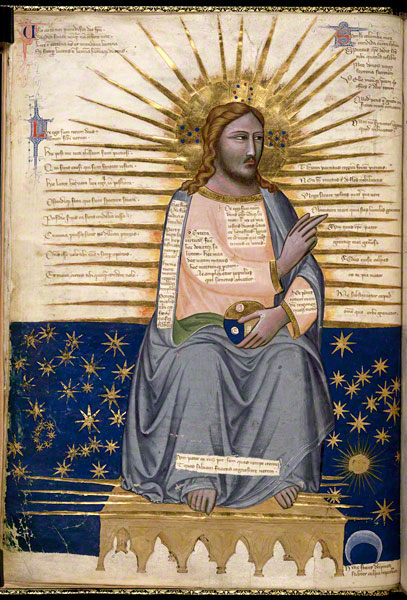Giotto & Pacino
During this period of dynamic growth in Florence, artists who worked as both panel painters and manuscript illuminators met the demand for artistic objects, secular and sacred, ranging from large altarpieces to luxury books. Giotto di Bondone was the pioneer in painting, and his approach to the human form and to storytelling influenced many of these artists. Pacino di Bonaguida, one of the most prolific artists of the period, led a workshop of artists and also collaborated on commissions with other artists of the time.
Giotto di Bondone

Giotto di Bondone was celebrated as a pioneering artist during his own lifetime. Even the poet Dante Alighieri acknowledged him to be the leading painter of the day. Artists, writers, and scholars since have characterized his style and its legacy by two main features: an increased naturalism in representing the human figure, and architectural and landscape settings that appear true to life. His work was highly sought within religious communities and banking families, among foreign rulers, and even by the pope. In addition to his work on panel and in fresco, he also designed stained-glass windows and mosaics and oversaw the construction of the Florence Cathedral bell tower and its sculptural program.
In the monumental altarpiece above, which is more than eight feet wide, Giotto depicted the five figures with great attention to natural detail, from realistic facial features to an awareness of the body beneath heavy garments to a profound dignity in posture and gaze. The altarpiece is associated with the Peruzzi family, important bankers in Florence, and their private chapel in the Church of Santa Croce, the major Franciscan foundation in the city.

The Virgin Mary with Saints Thomas Aquinas and Paul, about 1330, Bernardo Daddi. Tempera and gold leaf on panel, 47 7/8 x 44 1/2 in. (121.6 x 113 cm). The J. Paul Getty Museum
Panel painters like Bernardo Daddi and Taddeo Gaddi quickly absorbed Giotto's new methods on both a monumental and a small scale.
In the panel painting at left by Daddi, the Virgin Mary engages the viewer by extending her hand beyond a painted parapet, while smaller figures of Saints Thomas Aquinas and Paul fill the wings of this triptych. Daddi's reliance on Giotto's new naturalism is clear when this painting is compared to Giotto's altarpiece above: each figure seems to have mass and volume and the contours of their bodies appear beneath their garments, similar to Giotto's figures.
In the panel painting at left by Daddi, the Virgin Mary engages the viewer by extending her hand beyond a painted parapet, while smaller figures of Saints Thomas Aquinas and Paul fill the wings of this triptych. Daddi's reliance on Giotto's new naturalism is clear when this painting is compared to Giotto's altarpiece above: each figure seems to have mass and volume and the contours of their bodies appear beneath their garments, similar to Giotto's figures.
Loading the video
Pacino di Bonaguida
Pacino di Bonaguida was one of the most active artists in Florence in the first half of the 14th century. He produced altarpieces, large crucifixes, stained glass, and smaller scale devotional paintings and dominated the market for illuminated manuscripts in the city, decorating luxury choir books, liturgical manuscripts, and some of the earliest illustrated copies of Dante's Divine Comedy.

The Crucifixion, about 1315–20, Pacino di Bonaguida. Tempera and gold leaf on panel. 32 x 17 1/2 in. (81.2 x 44.5 cm). Fondazione di Studi di Storia dell'Arte Roberto Longhi di Firenze
Pacino's art demonstrates a great interest in storytelling and narrative detail, and his often-naturalistic figures reflect Giotto's influence. Above all, Pacino was an iconographic innovator, illustrating unprecedented subjects and introducing new details into traditional scenes.
This emotion-filled scene of Christ's crucifixion stands out dramatically against a solid black background that suggests the biblical description of the hours before his death when "there was darkness over the whole earth." This feature is highly unusual during this period, and it indicates Pacino's innovative approach to this popular subject matter, which he treated on numerous occasions. It also expresses the artist's mastery of storytelling and his understanding of the theological meaning of the events he depicted.
Pacino was also an accomplished manuscript illuminator. In the image below, the monumental and radiant figure of Christ turns to bless the Virgin Mary, who kneels in prayer before him on the opposite page (not seen here). The grand scale of the figures in this manuscript—just over 1 1/2 feet high— is highly unusual in manuscript illumination; they recall the substantial figures more typically found in panel painting, as in the work of Pacino's contemporaries Giotto and Bernardo Daddi (see images above).

This illumination is in a manuscript commissioned by the city of Prato to be presented as a gift to King Robert of Naples (Robert of Anjou) as a plea for his protection from the encroachment of Florence, which was seeking to expand and incorporate surrounding towns. The lines of the poetic text are creatively woven through and around the painted images, encouraging careful reading
and contemplation.
Publication
Florence at the Dawn of the Renaissance: Painting and Illumination 1300–1350
Edited by Christine Sciacca
Edited by Christine Sciacca
Related Information
At the Art Gallery of Ontario
- Revealing the Renaissance: Stories and Secrets in Early Florentine Art
March 16–June 16, 2013

